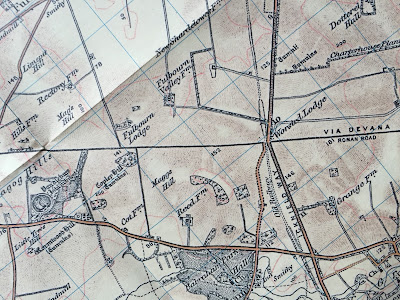English lads and lasses who made a happy return to their own lovely heritage—a set of black and white photos of the Roman Road near Cambridge
 |
| Wandlebury and the Roman Road (1898-1901 OS map) |
What sent Watkinss ideas viral was his urging of his readers to get out into the landscape and discover their own leys. His books conjured into being a collaborative cartography, a kind of crowd-sourcing avant la lettre. His recommendations came at a receptive moment [1925], as walking and back-to-nature movements underwent their revival in Britain. 'Ten years ago it was at very long intervals that we met other ramblers', a journalist called Fred Hando wrote in the South Wales Agus in 1934, discussing Watkins' influence, but:
'[t]oday the roads, the lanes, the meadow-paths are all 'a-ripple with mirth' at the merry bands of youngsters touring the countryside on foot. Take note, you sober-sided historians, how young, aged and middle-aged England greets post-War depressions. And you philosophers, look to it that the healthy sturdy tramps arrive not before you at a solution of your problems. With great satisfaction, therefore, let us record the happy return of the English lads and lasses to their own lovely heritage.'
Hando's prose is cutely of its time, but it testifies to the wayfaring revival of the late 1920s and 1930s — and to Watkins' part in it (The Old Straight Track, Head Zeus, 2015, pp. xxiii-xxv).
Well, my grandparents (and a couple of my older, so-called, aunts and uncles) were very much part of that generation. They all valued highly a walk in the woods/country that would take in some splendid natural or ancient site and they were often coupled with some elementary lessons on flora and fauna and sometimes with a folk tale or two thrown in for good measure. My maternal grandparents took me many times to Burnham Beeches whilst my paternal grandparents and an aunt and uncle introduced me over many years to the North Norfolk coast and The Brecks. My own parents did likewise, especially when it came to visiting ancient, historic sites.
The point is that, via them, I'm very much one of Watkins' children and, from time to time, I become very conscious of being one of the English lads and lasses who was helped to make a happy return to my own lovely heritage.
Now, when it comes to straight-tracks in my local neighbourhood perhaps the most well-known is the Roman Road which passes by the ancient hill fort of Wandlebury — the subject of last week's post. (Even though Watkins makes it clear he was not writing about Roman Roads this particular one is likely to have been an ancient track that was simply taken over and reused by the Romans.) Last week, I didn't make it out on to the Roman Road but, because yesterday (Monday) was such a pearl of a day, I couldn't resist mounting my bicycle and cycling up the Gog Magog hills to begin a walk along some of its length to Meg's Mount and, once again, to make a happy return to my own lovely heritage.
As ever, along the way I took a few photos (iPhone 6+ using the Blackie App) and post them below for your pleasure. The first five and the final one I took as I walked through Wandlebury Country Park to get to and from the road. Click on a picture to enlarge it.
Enjoy!
























Comments